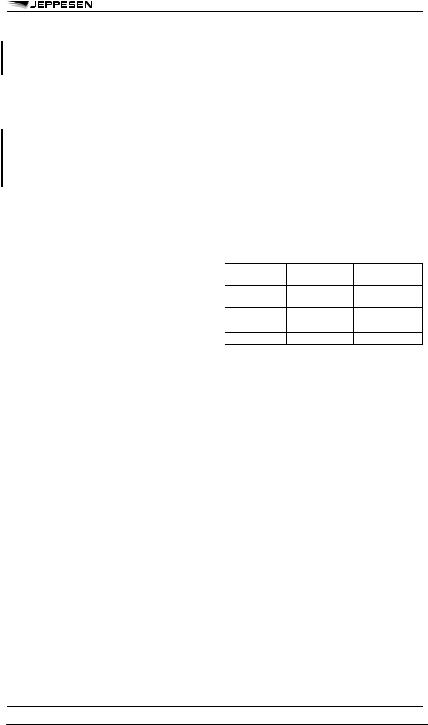
AIR TRAFFIC CONTROL
.pdf
UNITED KINGDOM-4 |
AIR TRAFFIC CONTROL 19 NOV 10 |
UNITED KINGDOM - RULES AND PROCEDURES
When a departing aircraft on a SID is cleared to climb to a level higher than the initially cleared level(s) specified in a SID, the aircraft shall climb directly to the cleared level, unless the SID vertical restrictions are reiterated as part of the clearance.
MAXIMUM RATES OF CLIMB AND DESCENT
In order to ensure the interaction of ACAS and ground based safety nets, other than aircraft in emergency and certain specific conditions for military aircraft, all aircraft when operating under normal circumstances, when inside Controlled Airspace within the London and Scottish FIRs/UIRs should not operate with a climb or descent rate exceeding 8000ft per minute. Aircraft when first approaching a cleared flight level and/or when changing flight level in controlled airspace should ensure that the vertical closure speed is not excessive. It is considered that, with about 1500ft to go to a cleared level, vertical speed should be reduced to a maximum of 1500ft per minute and ideally to between 1000ft per minute and 500ft per minute. Pilots should ensure that the aeroplane neither undershoots nor overshoots the cleared level by more than 150ft, manually overriding if necessary.
MINIMUM RATES OF CLIMB AND DESCENT
In order to ensure that controllers can accurately predict flight profiles to maintain standard vertical separation between aircraft, pilots of aircraft cleared for a climb or descent should inform the controller if their rate of climb or descent during the level change will be less than 500ft per minute or, if at any time during such climb or descent their vertical speed is, in fact, less than 500ft per minute.
This requirement applies to both the enroute phase of flight and to terminal holding above the Transition Altitude.
NOTE: This does not prohibit the use of rates of climb or descent less than 500ft per minute when operationally required.
POSITION REPORTING PROCEDURES
Pilots are to make position reports within London and Scottish FIR/UIR in the following circumstances:
–after transfer of communication;
–on reaching the limit of ATS clearance;
–when instructed by ATC;
–when operating helicopters in the North Sea Low Level Radar Advisory and Flight Information areas of responsibility and on Helicopter Routes within the London Control Zone and London/City Control Zone;
–when operating across the English Channel.
The initial call changing radio frequency shall contain only the aircraft identification and flight level. Any subsequent report shall contain aircraft identification, position and time except as provided for in respect of helicopter operations in the areas specified above.
When changing frequency between the London or Scottish Control Centres, pilots are required to state their callsign and Flight Level/Altitudes only (plus
any other details when specifically instructed by ATC). When the aircraft is in level flight but cleared to another FL/ALT, both FL/ALT should be passed. Similarly, when the aircraft is not in level flight, the pilot should state the aircraft identification followed by the FL/ALT to which it is cleared only; it is not necessary to state passing FL/ALT in these circumstances.
FLIGHT PLANNING
Shanwick Oceanic Control Area
All flights within this area are subject to IFR. Filing of a flight plan is compulsory. Flight plans for flights departing from points within adjacent regions and entering the NAT Region, without intermediate stops, should be submitted at least 3 hours prior to departure.
In addition to normal flight plan format the following information must be filed:
a.Item 18 should contain the accumulated estimated elapsed time to the first Oceanic boundary for flights conducted along one of the organized tracks.
b.Item 18 may include a request for a suitable alternative flight level.
c.Item 15 should include speed information in the following sequence:
1.Jet aircraft:
–cruising speed (TAS) in knots;
–oceanic entry point and cruising Mach number;
–landfall fix and cruising speed (TAS) in knots.
2.Other aircraft: same sequence but speed in terms of TAS in knots.
d.Item 15, route of flight. For flights conducted along one of the organized tracks, the track shall be defined by the abbreviation “NAT" followed by the code letter assigned to the track. For flights conducted wholly or partly outside the organized tracks, the latitude and longitude of each designated reporting line, 10W, 20W, 30W, 40W, 50W, 60W, Fishpoint and Landfall should be entered.
e.Item 18, remarks. For flights conducted wholly or partly outside the organized tracks in the NAT Region, accumulated estimated elapsed times over significant points enroute shall be specified in this section. The designated reporting lines are:
1.Flights Europe - North America:
Eastern boundary of the OCA and longitudes 20W and 30W
2.Flights Europe - Iceland:
Longitude 10W and latitude 61N (RATSU)
3.Flights Europe - Azores:
Longitude 0845W and latitude 45N
f.Flights entering Shanwick OCA directly from the SOTA, the estimated elapsed time (EET) for the Shanwick boundary filed in item 18 of the flight
© JEPPESEN, 1987, 2010. ALL RIGHTS RESERVED.

19 NOV 10 AIR TRAFFIC CONTROL |
UNITED KINGDOM-5 |
UNITED KINGDOM - RULES AND PROCEDURES
plans to be the EET for the point of crossing the Shanwick/SOTA boundary (RODEL/SOMAX/ BEDRA/KOGAD/OMOKO/TAMEL or LASNO).
g.For flights entering Shanwick OCA directly from the BOTA, the EET for the Shanwick OCA filed in item 18 of the flight plan is to be the EET for the point of crossing the Shanwick/BOTA boundary (ETIKI/SEPAL or SIVIR).
h.For flights exiting Shanwick OCA directly to the SOTA, the EET for the Shannon boundary filed in item 18 of the flight plan is to be the EET of crossing the Shanwick/SOTA boundary (RODEL/SOMAX/BEDRA/KOGAD/OMOKO/ TAMEL or LASNO).
i.For flights exiting Shanwick OCA directly to the BOTA, the EET for the Brest boundary filed in item 18 of the flight plan is to be the EET of crossing the Shanwick/BOTA boundary (ETIKI/ SEPAL or SIVIR).
j.For flights entering Shanwick OCA directly from the NOTA, the EET for the Shanwick OCA filed in item 18 of the flight plan is to be the EET for the point of crossing the Shanwick/NOTA boundary (VENER/RESNO/ETARI/PIKIL/BILTO/SUNOT or AGORI).
k.For flights exiting Shanwick OCA directly to the NOTA, the EET for the Shannon boundary filed in item 18 of the flight plan is to be the EET of crossing the Shanwick/NOTA boundary (VENER/RESNO/ETARI/PIKIL/BILTO/SUNOT or AGORI).
l.Item 18, remarks. For flights through SOTA airspace by aircraft not equipped with VHF RTF this should be annotated by entering “COM/UHF only”.
m.Flight plans for all flights within Shanwick OCA are to be addressed to EGGXZOZX.
ASSISTED FLIGHT PLAN EXCHANGE SERVICE (AFPEx)
AFPEx provides a gateway via the internet into the AFTN and allows pilots or small airfields access to file either their own flight plans and other flight related messages. Permission to use AFPEx will be granted to bonafide users only, based in the UK. This includes UK aerodromes, UK based airline operators and UK based pilots. Application and permission to use AFPEx may be obtained by making application to:
Civil Aviation Communications Centre (AFPEx) E-Mail: flightplanningonline@nats.co.uk
Addressing of Flight Plan Messages
The United Kingdom operates a collective addressing system which is detailed in Civil Aviation Publication CAP550 ’Random Flight Plan AFTN Address Book’ which is available from:
Tangent Direct |
|
|
Address: |
The Lypiatts, Lansdown Road, |
|
|
Cheltenham, Glos. GL50 2JA |
|
Tel: |
+44 |
(0) 870-8871410 |
Fax: |
+44 |
(0) 870-8871411 |
E-Mail: |
sales@tangentuk.com |
|
Internet: www.ais.org.uk
WAKE TURBULENCE CATEGORIES
General
Aircraft types B-707, DC-8, VC-10 and IL-62 have been re-classified and are now grouped into the weight category “MEDIUM” for separation purposes only. Pilots of these aircraft are not expected to add the word "HEAVY" to their call sign when establishing radio contact with ATC units or when changing frequencies.
Special Wake Vortex Categories at London (Gatwick/Heathrow/Stansted) and Manchester
Aircraft types B-757, B-707, DC-8, VC-10 and IL-62 are classified as “UPPER MEDIUM” for Wake Vortex purposes only. Other “MEDIUM” aircraft types are classified as “LOWER MEDIUM”. These categories are used for the purpose of spacing in the approach phase only and do not apply to departing aircraft.
Wake Turbulence Categories
NOTE: The aircraft wake turbulence group on the flight plan should be indicated according to the ICAO specification (H, M, or L).
COMMUNICATIONS
Frequency 123.45MHz is available in remote and oceanic areas out of range of VHF ground stations as air-to-air communication frequency.
Phraseology for use on Frequency 123.45MHz
As an aircraft may be maintaining watch on more than one frequency, the initial call should include the identification ’Interpilot’.
For use when making a directed call to a specific aircraft:
–’(Callsign of aircraft being called) (callsign of calling aircraft) interpilot, do you read.’
For use when making a general call:
–’Any aircraft vicinity of (specific position) (callsign of calling aircraft) interpilot (any additional appropriate information).’
RVSM EXEMPTIONS
RVSM Exemptions - Application Procedure
An application for an RVSM exemption will be treated on an individual basis, and will be issued for a specific period in respect of a specific aircraft, or a series of aircraft (e.g. in support to MoD tasks). Operators requiring RVSM exemption shall contact:
© JEPPESEN, 1987, 2010. ALL RIGHTS RESERVED.

UNITED KINGDOM-6 |
AIR TRAFFIC CONTROL 19 NOV 10 |
UNITED KINGDOM - RULES AND PROCEDURES
Head Controlled Airspace
Address: |
K6, G1 |
|
CAA House |
|
45-59 Kingsway |
|
London WC2B 6TE |
Tel: |
+44 (0) 20 7453 6553 |
Fax: |
+44 (0) 20 7453 6565 |
E-Mail: |
cas@caa.co.uk |
RVSM exemptions will be returned by quickest means. It is essential that the serial number is stated in the FPL otherwise entry into UK RVSM airspace will be refused.
Additional Flight Planning Requirements
For all flights, in item 15 a maximum of FL280 to the point where the flight wishes to enter the RVSM airspace. Do not enter details at FL290 or above anywhere in item 15.
For all flights, in item 18 include the RVSM Status and exemption serial number, e.g.
STS/UK RVSM EXEMPT.... Serial Number
NOTE 1: Operators of non RVSM approved aircraft are not to enter W in item 10 even in this specific exemption.
NOTE 2: An RVSM exemption does not confer any right to enter RVSM airspace as GAT unless specifically agreed by the appropriate ATC.
Flight Testing or CAA Airworthiness Test Flights
In item 15, enter route details, e.g. OAT, VLN, SMG, VLN, and then the return rejoining point to destination not above FL280. If airport of departure is outside the ATS route structure, insert the appropriate routing. If the final intention is to rejoin the ATS route structure, file to rejoin at the appropriate point not above FL280.
In item 18, insert RVSM status and Exemption Serial Number (If applicable) and: “RMK/Flight Testing”, or “RMK/CAA Airworthiness Flight Test” as appropriate with requested FL in RVSM airspace.
Overflight of Strumble HMU
Aircraft should file flight plan via Strumble in accordance with standard routing. If flying along ATS routes specifically to STU, insert the required routing to destination. For flights intending to receive a service from London Radar (Military Control) for the purposes of conducting Air Tests or CAA Airworthiness Test flights prior to overflying the Strumble HMU, or intending to fly OAT (off route) to facilitate flight over the Strumble HMU without flying along the ATS route structure, the appropriate routing shall be filed. In item 18 of the FPL add: “RMK/HMU FLT” beside other details.
Flights using GMU Equipment for RVSM monitoring
For flights using GMU equipment to complete an RVSM monitoring flight, the appropriate route should be filed, whether intending to fly as OAT or GAT. Beside details in item 15 and 18 add under item 18: “RMK/GMU FLT”.
Notification to ATC
Captains must pre-arrange handling in RVSM airspace by contacting the appropriate ACC Supervisor or Military Supervisor as appropriate on one of the following numbers:
a.LACC Civil Supervisor: +44 (0) 1 489-612420
b.London Radar Senior Military Supervisor: +44
(0) 1 489-612720
c.ScACC Civil Supervisor: +44 (0) 1 292 692763
d.ScATCC (Mil) Military Supervisor: +44 (0) 1 292 692361
In addition to filing the appropriate flight plan in order to ensure correct handling, captains should also pass the relevant flight profile details to the appropriate ATC supervisor.
Operators requiring overflight over the Scramble HMU should avoid peak periods as ATC need to provide 2000ft separation against traffic above FL290. If in doubt suitable timings can be arranged with the LACC Civil ATC Supervisor.
DIFFERENCES FROM ICAO STANDARDS AND PROCEDURES
ICAO REFERENCE
DEFINITIONS
Special VFR Flight — A flight at any time in a Control Zone which is Class A airspace or in any other Control Zone in IMC or at night in respect of which the appropriate ATC unit has given permission for the flight to be made in accordance with special instructions instead of in accordance with the Instrument Flight Rules and in the course of which flight the aircraft complies with any instructions given by that unit and remains clear of cloud and in sight of the surface.
Straight Ahead — “Maintain Final Approach Track”.
ANNEX 2
3.3.1.2 a. Flight plans are not required for aircraft flying within Advisory Airspace unless they intend to participate in Advisory Service.
b. It is advisable to file a flight plan if a flight involves flying over the sea, more than 10 miles from the UK coast, or flying over sparsely populated or mountainous areas, where Search and Rescue operations would be difficult.
3.3.5.3 The UK requires a pilot flying to a destination without an ATS or AFS facility, prior to departure, to notify a responsible person at the destination of his ETA. The responsible person will inform the parent ATSU if the aircraft fails to arrive within 30 minutes of the ETA. In the event of a pilot unable to find a responsible person at his destination he may request his parent ATSU to act in this capacity. Should this occur, the pilot is required to inform the parent ATSU within 30 minutes of arrival at destination.
4.1 The UK conforms to the ICAO table of VMC minima except as follows:
a.Additionally, in class “C”, “D” and “E” airspace, VFR flight is allowed by aircraft, other than helicopters, at or below 3000ft AMSL at a speed
© JEPPESEN, 1987, 2010. ALL RIGHTS RESERVED.

29 OCT 10 AIR TRAFFIC CONTROL |
UNITED KINGDOM-7 |
UNITED KINGDOM - RULES AND PROCEDURES
of 140kt or less, which remain clear of cloud and in sight of the surface and in a flight visibility of at least 5Km. Helicopters may fly VFR in class “C”, “D” or “E” airspace at or below 3000ft AMSL provided that they remain clear of cloud and in sight of the surface.
b.In class “F” and “G” airspace the VMC minima at and below FL100 apply down to the surface (instead of down to 3000ft AMSL) with the minima at and below 3000ft AMSL as an alternative.
4.2In Control Zones which are notified as class C, D or E airspace:
a.The cloud base minima does not apply to fixed wing aircraft at or below 3000ft AMSL at a speed of 140kt or less provided that they remain clear of cloud and in sight of the surface (the visibility minima applies);
b.neither the cloud ceiling nor visibility minima apply to a helicopter operating below 3000ft AMSL provided that it remains clear of cloud, with the surface in sight and in a flight visibility of at least 1500m.
4.3VFR flight is not permitted at night.
4.4(a) VFR flights are permitted above FL200, except in certain Areas notified in UK publications as class A airspace.
4.5VFR flight by GAT is not permitted at and above FL290, VFR flight by OAT is permitted and will be provided with 2000ft vertical separation.
4.6a. In addition to the minimum height of 1000ft over a congested area, the UK stipulates that an aircraft flying over a congested area of a city, town or settlement shall not fly below such height as would permit the aircraft to land clear of the congested area in the event of the failure of a power unit.
b. There is no minimum height above the ground or water but an aircraft may not, except with the written permission of the CAA, be flown closer than 500ft to any person, vessel or structure. Additional restrictions are placed on flights flying over, or landing and taking off near, open-air assemblies of more than 1000 people. The minimum heights apply to all flights, regardless of Flight Rules, and in all weather conditions.
4.7 It is not mandatory for VFR flights to adopt any particular cruising level system. However, when operating above Transition Altitude they are recommended to conform to the cruising level system prescribed in the UK for IFR flights. In those parts of controlled airspace where VFR flight is permitted, such flights are not required to adopt any particular cruising level system.
5.1.2 (a) The United Kingdom has no statutory regulations relating specifically to minimum IFR altitude when operating over high terrain or mountainous areas.
5.1.2 (b) Aircraft operating under IFR shall not fly at a height less than 1000ft above the highest fixed obstacle within a distance of 5NM from the aircraft
unless the aircraft is flying on a route so notified or is operating at or below 3000ft AMSL and remains clear of cloud and in sight of the surface.
5.3.1 The UK operates a ’Quadrantal Rules’ system above 3000ft and up to FL195 with separation of 500ft between levels for IFR flights below FL195. Note: All UK airspace above FL195 is controlled airspace.
Appendix 1.3
Visual signals used to warn an unauthorized aircraft flying in, or about to enter a Restricted, Prohibited or Danger Area are not utilized by the UK.
© JEPPESEN, 1987, 2010. ALL RIGHTS RESERVED.
